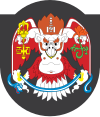
Back Ulan Bator ACE Ulaanbaatar Afrikaans ኡላዓን ባዓታር Amharic Ulán Bator AN أولان باتور Arabic اولان باتور ARZ Ulán Bátor AST Ulan-Bator Azerbaijani اولانباتور AZB Улан-Батор Bashkir



Ulaanbaatar (/ˌuːlɑːn ˈbɑːtər/; Mongolian: Улаанбаатар, pronounced [ʊˌɮaːm‿ˈpaːʰtə̆r] lit. "Red Hero"), or Ulan Bator, is the capital and largest city of Mongolia. The city is an independent municipality not part of any provinces. About half the population of Mongolia, about 1.5 million people, live in the city.[1][2]
Located in the north central part of the country, the city is at an elevation of about 1310 m in a valley on the Tuul River. The city is the country's center for culture, industry and finance, and since it is more than 13 times bigger than the second largest city in Mongolia, Erdenet, it is the country's primate city.[3] Ulaanbaatar is connected by highway to all the major towns in Mongolia and by rail to the Trans-Siberian Railway and Chinese railroad network. The city was founded in 1639 as a Buddhist monastery center and, in the 20th century, grew into a major manufacturing center.
- ↑ Mongolian Statistical Information Service
- ↑ "Mongolia: Provinces, Major Cities & Urban Settlements – Population Statistics, Maps, Charts, Weather and Web Information". Retrieved 2017-11-25.
- ↑ "List of cities in Mongolia". Wikipedia. 2018-02-16.
© MMXXIII Rich X Search. We shall prevail. All rights reserved. Rich X Search